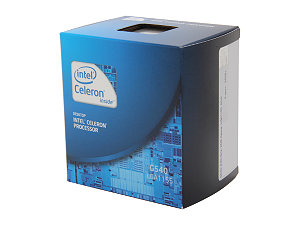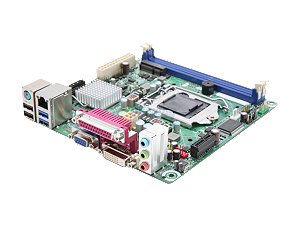Holiday 2012 Small Form Factor Buyer's Guide
by Zach Throckmorton on December 5, 2012 1:55 AM ESTSmall Size, Small Price Tag
While Intel has yet to release Ivy Bridge-based Celeron-class (i.e. cheap) CPUs, I briefly reviewed the Celeron G530's performance in a previous budget buyer's guide. Intel has, however, given its entry-level chips a modest speed bump in that the Celeron G540 and G550 models are often available for a dollar or two more than the G530. Because they are adequate for day-to-day tasks and are priced so low, they remain the kings of the budget CPUs.
 We've paired the Celeron G540 with one of the least expensive ITX Socket 1155 motherboards, Intel's BOXDH61DLB3. While there are less expensive boards, reliability issues prevent us from giving them the nod in this buyer's guide. Intel's entry-level ITX model offers basic features as well as USB 3.0 ports. Note that it does not have a PCIe x16 lane, instead offering a single PCIe x1 lane. This is likely not a concern for a budget, general office productivity box that will likely never need a video card installed but might need a wireless adapter card. Furthermore, its SATA ports are limited to SATA II speeds, so the newest SSDs that use SATA III will be crippled. Again, though, this is a budget system and something has to give. If you need a PCIe x16 lane and SATA III ports, you'll need to step up to a board like ASRock's B75M-ITX or ASUS' P8H77-I.
We've paired the Celeron G540 with one of the least expensive ITX Socket 1155 motherboards, Intel's BOXDH61DLB3. While there are less expensive boards, reliability issues prevent us from giving them the nod in this buyer's guide. Intel's entry-level ITX model offers basic features as well as USB 3.0 ports. Note that it does not have a PCIe x16 lane, instead offering a single PCIe x1 lane. This is likely not a concern for a budget, general office productivity box that will likely never need a video card installed but might need a wireless adapter card. Furthermore, its SATA ports are limited to SATA II speeds, so the newest SSDs that use SATA III will be crippled. Again, though, this is a budget system and something has to give. If you need a PCIe x16 lane and SATA III ports, you'll need to step up to a board like ASRock's B75M-ITX or ASUS' P8H77-I.
Housing the budget build is Apex's MI-008, a longtime favorite of mine for cheap ITX systems. It's reasonably well-constructed, and comes with a serviceable 250W power supply. Its thermals aren't particularly impressive, but for a system lacking a discrete graphics card and running a Sandy Bridge Celeron, it doesn't need to have the best airflow. The MI-008 can accommodate full size hard and optical drives, which helps keep costs down.
 As for the memory, a single 4GB stick of budget DDR3-1333MHz is sufficient for basic computing in Windows 7 64-bit (or Windows 8 if you want to go that route), and leaves an open slot so upgrading to 4GB in the future will be cheap and easy. Hard drive and solid state drive prices are especially dynamic this time of year, making recommendations difficult. While day to day hard drive prices remain elevated in the wake of the notorious Thailand floods, sale prices are beginning to get back to where they were before hard drive supplies were disrupted late last year. If you're patient and pay attention to prices, you will likely be able to snag a mainstream 7200RPM 1TB hard drive for $60 or less. If you don't need much local storage, a 64GB SSD will give you an enormous performance boost for about the same price.
As for the memory, a single 4GB stick of budget DDR3-1333MHz is sufficient for basic computing in Windows 7 64-bit (or Windows 8 if you want to go that route), and leaves an open slot so upgrading to 4GB in the future will be cheap and easy. Hard drive and solid state drive prices are especially dynamic this time of year, making recommendations difficult. While day to day hard drive prices remain elevated in the wake of the notorious Thailand floods, sale prices are beginning to get back to where they were before hard drive supplies were disrupted late last year. If you're patient and pay attention to prices, you will likely be able to snag a mainstream 7200RPM 1TB hard drive for $60 or less. If you don't need much local storage, a 64GB SSD will give you an enormous performance boost for about the same price.
While Windows 7 64-bit remains the de facto standard operating system for PCs, note that Windows 8 64-bit is now also available. Note that for this budget build, the $92 Windows license accounts for about 25% of the total cost. If you're on an extremely tight budget, or simply want to explore other operating systems, be sure to check out a free OS like Ubuntu.
| Component | Product | Price |
| Case | Apex MI-008 | $48 |
| Power supply | (included with case) | |
| CPU | Intel Celeron G540 2.5GHz dual-core | $45 |
| Motherboard | Intel BOXDH61DLB3 mITX | $72 |
| RAM | G.Skill Value 4GB DDR3-1333MHz | $18 |
| Hard drive | Seagate Barracuda 1TB ST1000DM003 | $70 |
| SSD alternate | Intel 330 Series 60GB | $70 |
| Optical drive | Samsung SH-224BB DVD burner | $16 |
| Operating system | Windows 7 64-bit Home Premium OEM | $92 |
| Total: | $361 |
Check the next page for our small form factor file server build.










74 Comments
View All Comments
shurik_1 - Wednesday, December 5, 2012 - link
As I wrote in comments to ASRock Vision HT 321B review there is at least one ASRock product that has issue with silent data corruption that it refuses to fix and does not inform users that their data is in jeopardy. How can you recommend the MB from the company with such track record?just4U - Wednesday, December 5, 2012 - link
"Though the K-series chip is easy to overclock and doesn't produce much additional heat (vs. stock)"-------------------
THIS is somewhat misleading.. and readers need to be very aware of the fluxuations in temperatures on the new Intel cpu's regardless of what casing and cooling solutions they use..
Personally I am quite upset with intel. I'd thought they'd finally moved away from the heatscore solution which in my opinion hurts the longevity of a computer. If I can get them I still default to a sandybridge cpu over these newer proccessors.
Piano Man - Wednesday, December 5, 2012 - link
I don't get all of the adulation Prodigy gets, especially for gaming. Look at it's dimensions and weight. Over 17lbs and 9.84" x 15.91" x 14.13" . And its mini-ITX.Temjin TJ08-e is around 12 lbs and 15.16" x 8.27" x 14.72". And its Micro ATX and can hold 2 GPUs and a Heatsink like the Noctua D14. Not to mention it has a massive 180mm intake.
The Prodigy would be better if it got rid of those stupid handles that waste space. Hard to recommend a mini-ITX that is bigger than a uATX case.
just4U - Wednesday, December 5, 2012 - link
I quite like the case your refering to.. (my 2700K build here..) http://imageshack.us/a/img607/4497/dscf0512k.jpgYour right to you can fit a whole helluva lot into it and it still seems quite roomy. It's not the easiest case to work with though..
abrogan - Friday, December 7, 2012 - link
I just finished two high-end builds, with the first computer using the Temjin and the second the Prodigy.The Prodigy is surprisingly large but easy to build (especially with a stubby screw driver). Lots of room to put extra cables along the sides. Be careful to buy a 140mm psu, as the first PSU I purchased didn't fit. I liked all the colour options (-:
The Temjin fit all standard supplies 160mm or shorter so it gets the nod from me for wide compatibility. Perfect for the professionals. My friends all liked the look of the Temjin better but the Prodigy is for the oddballs out there who like high quality soft touch plastic looking Mac Pros.
The Prodigy was just fun because of its unique nature however I would ask Bitfenix to make the plastic fins an optional feature as well. There are no rubber feet to provide access to the PSU on the bottom without the fins installed and there are gaps on top without the top fin. If you could remove the plastic fins I'd say it would be pretty awesome and 30 dollars cheaper than the Temjin!
Both are pretty nice!
Wrathgar11 - Saturday, December 8, 2012 - link
You are so right.I thought seriously about the Prodigy case before I bought my Node 304. No regrets, IMHO the Node beats it hands down and fits under my TV too.
An under-rated case is the Core 1000, which Fractal sell as a mini ITX/micro ATX case. In reality the internal dimension are too small for an mATX board, but as an enclosure for a mini ITX desktop system (my current setup) it is brilliant.
Core 1000 is no good as a gaming case, but for this application it rocks.
Great price too, I got it from Enta around £25.
pvdw - Monday, December 10, 2012 - link
Love the TJ08-E! It's almost completely inaudible with a Seasonic S12II-430 and the front fan slowed ever so slightly.Plus, how are gamers supposed to do a dual-GPU config in mini-ITX? Easy in the TJ08-E.
pvdw - Monday, December 10, 2012 - link
BTW, forgot to mention that it also gets an Editor's Choice from SPCR.xismo - Wednesday, December 5, 2012 - link
I've been interested in a small form factor build for a while but for a different reason. I travel around and live in different places usually for extended periods of time (1+ year). So the possibility of putting my pc in a carry on and only having to buy a $200 display after I get where I need to go while still getting double the power of a laptop was always very intriguing. But I never pulled the trigger mostly because I should eventually settle down and so want to build a full build.Can you guys recommend the smallest possible case that can accommodate either mini-ITX or preferrably micro-ATX (would like to have 4x ram slots) while also having enough room for a GPU (nothing too powerful something like 630 or 640). Do you think it's even possible to cool the specs mentioned above appropriately with a quad core i5 in a small case that can fit in a carry on?
KAlmquist - Wednesday, December 5, 2012 - link
I'm guessing that the power supply in the budget build is an Apex AL-8250SFX from Allied Leader International, manufactured by Deer Electronics/Solytech. Deer/Solytech is a name you probably recognize only if you read <a href="http://www.hardocp.com/article/2007/10/03/50_power... of cheap power supplies</a> for their <a href="http://www.hardocp.com/article/2007/05/23/450w500w... value</a>.As far as I can determine, a decent power supply cannot be built for less than about $40. Back in July, Anandtech published <a href="http://www.anandtech.com/show/6013/350450w-roundup... Roundup: 11 Cheap PSUs</a>." Martin Kaffei's conclusion about the $28 unit: <a href="http://www.anandtech.com/show/6013/350450w-roundup... PSUs have no right to exist."</a>
Based on price and pedigree, I'd wager that the power supply in the budget build is crap. If I'm wrong, that's a "man bites dog" story and Anandtech should do a full review of this PSU.